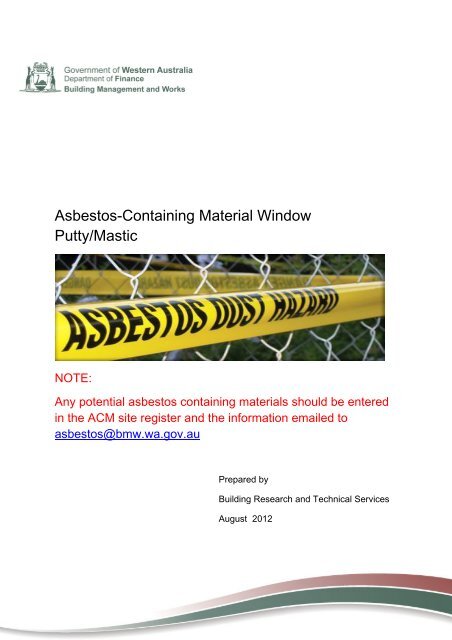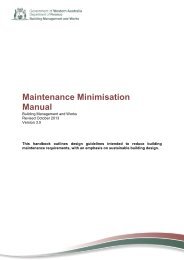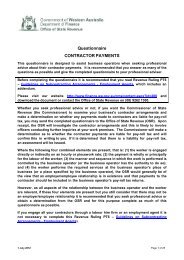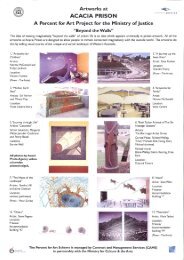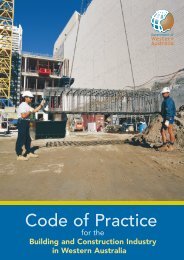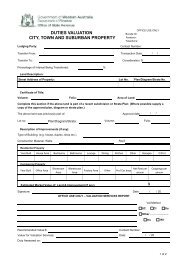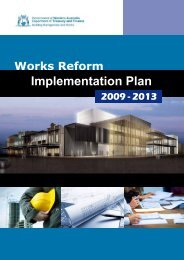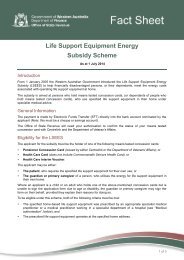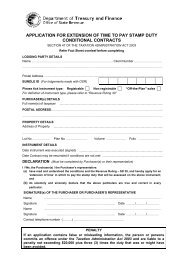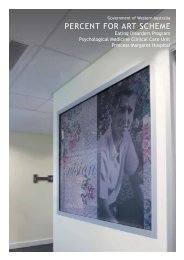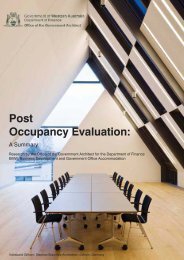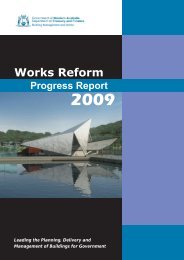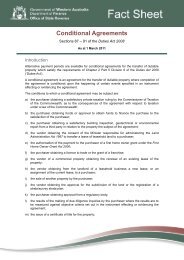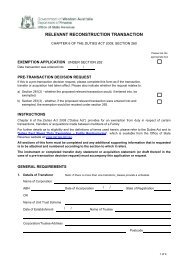Asbestos-Containing Material Window Putty/Mastic
Asbestos-Containing Material Window Putty/Mastic
Asbestos-Containing Material Window Putty/Mastic
Create successful ePaper yourself
Turn your PDF publications into a flip-book with our unique Google optimized e-Paper software.
<strong>Asbestos</strong>-<strong>Containing</strong> <strong>Material</strong> <strong>Window</strong><br />
<strong>Putty</strong>/<strong>Mastic</strong><br />
NOTE:<br />
Any potential asbestos containing materials should be entered<br />
in the ACM site register and the information emailed to<br />
asbestos@bmw.wa.gov.au<br />
Prepared by<br />
Building Research and Technical Services<br />
August 2012<br />
1
‘<strong>Window</strong> putty/mastic’- potentially containing asbestos material<br />
Introduction<br />
In May 2012 the Australian Glass & Glazing Association Inc released a safety alert:<br />
‘In line with the Work Health and Safety Regulation 2011, this alert refers to the<br />
possibility of asbestos fibres being present in putty used on steel/aluminium framed<br />
windows sealed with steel frame putty that was originally installed prior to 2004’.<br />
The Australian Government, National Occupational Health and Safety Commission<br />
2008 defines ‘<strong>Asbestos</strong> <strong>Containing</strong> <strong>Material</strong>’ (ACM) as any material, object, product<br />
or debris that contains asbestos. 1<br />
<strong>Asbestos</strong> fibres were used to reinforce window putty/mastic compounds in Australia<br />
from 1930 to 1985. Some of the major suppliers of the putty were Flintkote, Tremco<br />
Group, DAP Products Inc, Glastick <strong>Putty</strong> and Buttler <strong>Putty</strong>. 2<br />
BMW research in response to the AGGA safety alert and has established that ACM<br />
window putty/mastic has been used to seal glass into steel and aluminium frames.<br />
Little empirical evidence exists that ACM putty was used for wood framed windows. 3<br />
ACM window putty/mastic is unlikely to be friable nor a meaningful source of<br />
airborne asbestos hazards in its bonded state, except perhaps during demolition of a<br />
very large amounts of such material or when being mechanically ground out for glass<br />
repair. 4<br />
A total ban on all ACM in Australian products was effective from the 31 st December<br />
2003. <strong>Window</strong> putty/mastic found in site glazed steel/aluminium framed windows in<br />
buildings built prior to this date should be treated as containing asbestos material.<br />
Statutory Obligation<br />
Agencies have a statutory obligation under the Occupational Safety and Health Act<br />
1984 (the Act) and the Occupational Safety and Health Regulations 1996 (the<br />
Regulations) to provide a safe workplace for employees, whether that workplace is<br />
owned or leased. Although there are occasions where multiple duty holders exist for<br />
a single premise, agencies are still obligated as persons in control of that workplace<br />
to ensure it is safe. 5<br />
1 http://www.safeworkaustralia.gov.au/sites/SWA/AboutSafeWorkAustralia/WhatWeDo/Publications/Pages/C<br />
P2005ManagementAndControlOf<strong>Asbestos</strong>.aspx<br />
2 Safe Environments.com.au<br />
3 Environmental Health Solutions Victoria & National Association of Testing Authorities Australia (NATA)<br />
4 Environmental Health Solutions Victoria & <strong>Asbestos</strong> Network , Murdoch University Western Australia<br />
5 http://www.finance.wa.gov.au/cms/uploadedFiles/Building_Management_and_Works/<strong>Asbestos</strong>_Steering_Co<br />
mmittee_‐_Information_Guide_for_Agencies.pdfn=8455<br />
2
Legislative Requirement<br />
The Agency as an employer, has responsibility to maintain a safe working<br />
environment under the provisions of:<br />
• Regulation 3.1a of the Occupational Safety and Health Regulations 1996 (OSH<br />
Regulations 1996), which requires an employer to identify hazards at a<br />
workplace, assess the risk of harm to a person from each hazard and to take<br />
steps to reduce the risk.<br />
• Regulation 5.43 (OSH Regulations 1996) which specifically requires the presence<br />
and location of asbestos at a workplace to be identified and that the process of<br />
identification and risk assessment is conducted in accordance with the Code of<br />
Practice for the Management and Control of <strong>Asbestos</strong> in Workplaces<br />
[NOHSC:2018 (2005)].<br />
Recommendations<br />
Recommendation 1: BMW contract project managers should alert relevant<br />
contractors to the Australian Glass & Glazing Association Inc, AGGA SAFETY<br />
ALERT-“Hacking out and removing steel/aluminium putty”. 6 Note that relevant<br />
contractors may include but not be limited to: demolition and construction<br />
contractors, glaziers, painters, window fabrication and installers, and any<br />
miscellaneous tradesmen involved in maintenance or refurbishments.<br />
Recommendation 2: In specific instances where the presence of asbestos in<br />
window putty is suspected:<br />
a. In the Perth Metropolitan area and areas covered by Service Arranger<br />
Contracts, the panel contractors and the BMW metropolitan Breakdown<br />
Repair team engage licensed asbestos contractors. 7<br />
b. In regional areas Regional Contractors (including Service Alliance<br />
Contractors) involved in window repair, contact the local BMW office to<br />
determine further action 8<br />
Recommendation 3: <strong>Window</strong> putty/mastic in steel/aluminium framed windows<br />
should only be removed when reglazing or repairing damaged putty is necessary.<br />
6 http://nswgga.org.au/wp‐content/uploads/Safety‐Alert‐<strong>Asbestos</strong>.pdf<br />
7 BMW Breakdown Procedures Manual 2009 page 17 “Work requiring additional trades’<br />
8 BMW regional staff in consultation with the contractor, determine the presence of ACM, based on age of<br />
building etc, whether to use work practices in accordance with the Health and Safety Executive (HSE) (UK)<br />
work sheet a37. Removing asbestos‐containing mastic, sealant beading , filler putty or fixing or engage a<br />
licensed asbestos contractor, http://www.hse.gov.uk/pubns/guidance/a37.pdf<br />
3
The Service Arranger Contracts in the metropolitan area and the Service Alliance<br />
Agreements in the regions do not require contractors to hold unrestricted asbestos<br />
licence and it is not practicable to impose such a condition to the allocation of further<br />
work.<br />
The Zone Maintenance Contract for Glazing zones 1 & 2, Clause 3.2.2 states in part:<br />
the glazing contractor can appoint a person or business that holds the appropriate<br />
asbestos removal licence to remove the ACM putty/mastic on their behalf. The<br />
Service Alliance agreements and other arrangements with contractors in regional<br />
areas make no such provisions.<br />
Recommendation 4: Specific clauses and information will be required in future<br />
contracts and documents to ensure contractors understand safe working practices<br />
and their obligations relating to ACM.<br />
Recommendation 5: A safe work procedure for use by contractors working on<br />
ACM window putty/mastic be developed by BMW for inclusion in the <strong>Asbestos</strong><br />
Booklet to enable contractor to remove the material themselves without engaging a<br />
licensed asbestos remover where it is safe to do so.<br />
Dealing with window putty/mastic (suspected ACM)<br />
The removal, repair or maintenance of ACM window putty/mastic should be treated<br />
in accordance with the guidelines set for dealing with asbestos in the work place<br />
including reference to the <strong>Asbestos</strong> Management Plan, the <strong>Asbestos</strong> Booklet and the<br />
‘Code of Practice for the Safe Removal of <strong>Asbestos</strong>- 2 nd Edition’ [NOHSC:<br />
2002(2005)]. These documents give some guidance to the safe removal of ACM. 9,10<br />
Unrestricted Licence allows people to remove all forms of asbestos (friable and<br />
non friable) and replaces the current asbestos removal licence. 11,12<br />
Restricted Licence (commenced June 2010) allows people to remove amounts<br />
exceeding 10 square metres of bonded (non friable) asbestos. 13<br />
9 http://www.finance.wa.gov.au/cms/uploadedFiles/Building_Management_and_Works/AMP_template.docn<br />
=5732<br />
10 http://www.finance.wa.gov.au/cms/uploadedFiles/Building_Management_and_Works/asbestos_booklet100<br />
111(1).pdfn=7031<br />
11 http://www.commerce.wa.gov.au/worksafe/content/Services/Certification_registration_and/<strong>Asbestos</strong>_rem<br />
oval_licence_No_3.html#Unrestricted%20licence<br />
12 Friable <strong>Asbestos</strong> : means material that can be crumbled, pulverised or reduced to a powder by hand<br />
pressure when dry that contains asbestos. Non Friable : means material containing asbestos that is not<br />
friable, including materials containing asbestos fibres reinforced with a bonding component (code of Practice .<br />
How to safely remove asbestos)<br />
13 http://www.commerce.wa.gov.au/worksafe/content/Services/Certification_registration_and/<strong>Asbestos</strong>_rem<br />
oval_licence_No_3.html#Restricted%20licence<br />
4
<strong>Window</strong> putty/mastic containing asbestos material is referred to as non friable/low<br />
risk product in its original state. However as it deteriorates with age (see Figure 1), is<br />
sanded, scraped or mechanically ground there is a risk that asbestos fibres may be<br />
released (friable) and therefore this risk needs to be managed.<br />
Figure 1: Example of window putty used in a steel window frame. The second image is a close up of<br />
the putty in this frame. Note: (this putty was tested and asbestos material was detected) image<br />
courtesy of inspectapedia.com 2009.<br />
5


